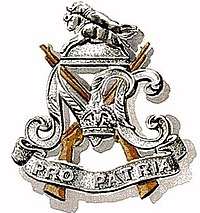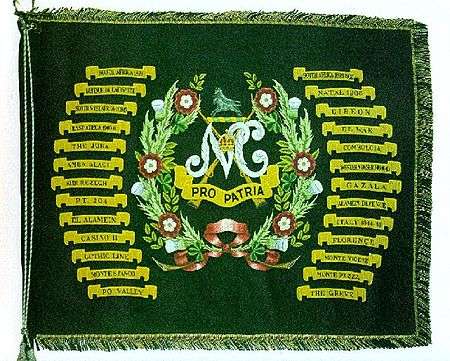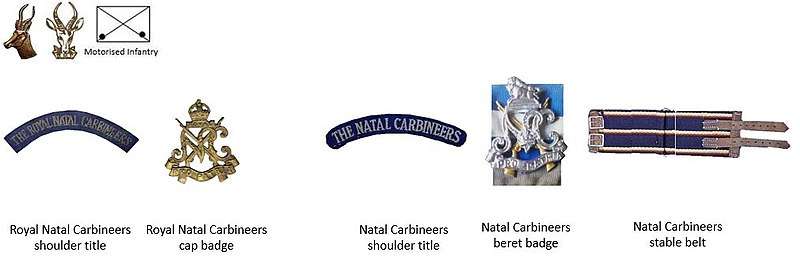Natal Carbineers
| Natal Carbineers | |
|---|---|
 SANDF Natal Carbineers emblem | |
| Active | 13 March 1855 to present |
| Country |
|
| Allegiance | |
| Branch | |
| Type | Infantry |
| Role | Motorised Infantry |
| Size | One Battalion |
| Part of |
South African Infantry Formation Army Conventional Reserve |
| Garrison/HQ | The Drill Hall, Pietermaritzburg |
| Nickname(s) | One Carbs |
| Motto(s) | Pro Patria (For the Fatherland) |
| Anniversaries | 13 March (Regimental Day) |
| Battle honours | |
| Insignia | |
| Company level Insignia |
 |
| SA Motorised Infantry beret bar circa 1992 |
 SA Motorised Infantry beret bar |
The Natal Carbineers Regiment is an infantry unit of the South African Army. As a reserve unit, it has a status roughly equivalent to that of a British Army Reserve or United States Army National Guard unit.
History
Origins
The Natal Carbineers Regiment traces its roots to 1854 but it was formally raised on 15 January 1855 and gazetted on 13 March of that year.
With the Union Defence Force
In 1913, the Regiment’s two ‘wings’ became known as the First and Second Mounted Rifles (Natal Carbineers) and in 1934 they re-assumed the name 1st and 2nd Natal Carbineers.
The following year, they became the Royal Natal Carbineers, a title which remained in use until the country became a republic in 1961.
Campaigns
Since its inception, the Natal Carbineers have participated in every campaign in KwaZulu-Natal. Their baptism of fire came during the Langalibalele Rebellion in 1873 where they suffered their first casualties in action in the Drakensberg. Subsequently, during the Anglo-Zulu War, the Carbineers suffered heavy losses at the Battle of Isandlwana on 22 January 1879.[1]
List of campaign and battle honours

South Africa, 1879
The Natal Carbineers participated in the invasion of Zululand in January 1879, and on 22 January, 23 members of the Regiment perished in the famous battle of Isandlwana. The unit was subsequently relegated to garrison duties at Landman’s Drift on the Mzinyathi, or Buffalo River.
South Africa, 1899–1902
In September 1899, the Natal Carbineers were mobilized for active service in the British campaign to subdue the Boer republics of the Transvaal and Orange Free State. The Regiment served until October 1900, when the Natal Volunteer Forces were demobilized. Some men continued their service in the Volunteer Composite Regiment until the end of the war in May 1902.
- Ladysmith, KwaZulu-Natal: From 2 November 1899 until 28 February 1900, the bulk of the Natal Carbineers was besieged in Ladysmith, and played a prominent part in that famous engagement. The most prominent military action was the attack by Colonial Forces on the Boer artillery emplacement at Gun Hill on the night of 7–8 December 1899. The Regiment lost heavily from the diseases that ravaged the garrison. A solitary squadron of the Natal Carbineers, the Estcourt-Weenen Squadron, avoided the siege of Ladysmith, and instead participated in the relief operations of Sir Redvers Buller as part of Hubert Gough's Composite Regiment. This squadron’s most notable military action of this period was the disastrous battle of Colenso on 15 December 1899, when four men were killed. These were their most serious losses for any one action during the Anglo-Boer War.
Natal, 1906
The Natal Carbineers saw extensive service in the Natal (or Bambatha) Uprising of 1906. From February to July 1906, the Regiment participated in the numerous sweeps and drives through the mountainous terrain of Zululand, as the Natal Colonial forces sought to trap and destroy the elusive ‘rebel’ warriors. The Carbineers were present at the decisive battle at Mhome Gorge on 10 June, where the back of the uprising was broken.
South-West Africa, 1914–1915
The Natal Carbineers, then known as the 1st and 2nd Mounted Rifles, were mobilized on 23 August 1914. Both battalions saw service in German South-West Africa, while the 2nd Battalion was also involved in the suppression of the short-lived Afrikaner Rebellion of 1914.
- Gibeon: The climactic battle of the South African campaign in German South-West Africa was fought at Gibeon Station on 25 April 1915. The Carbineers lost two men killed in the engagement.
East Africa, 1940–1941
On 17 July 1940 the 1st (Royal) Natal Carbineers sailed for Kenya as part of the 1st South African Brigade. Their destination was the Italian colonial empire in East Africa. For the next 10 months the Regiment participated in the South African advance through Italian Somaliland and Abyssinia (now Ethiopia), until Italian resistance was broken at Amba Alagi in May 1941.
- El Wak: The first major engagement of the East African campaign for the Carbineers was fought on 16 December 1940 at the Italian border post of El Wak, on the northern Kenyan frontier with Italian Somaliland. The Regiment lost its first World War II casualty, Sergeant Athol Paton, in this otherwise successful clash.
- The Juba: The Juba River was the Italian Army’s major defensive line in Somaliland. Several actions were fought during January and February 1941, at Gobwen and Giumbo, but the period is best remembered for the disastrous ambush on 22 February of a Carbineer patrol at Gelib. Twelve men lost their lives.
- Kombolcha: The engagement at Kombolcha in Ethiopia on 22 April 1941 followed the occupation of the capital city, Addis Ababa in March. The fighting at Kombolcha was distinguished by a daring nocturnal route march to successfully outflank Italian mountain-top positions. The battle honour awards refer to the general period 17 to 25 April.
- Amba Alagi: Italian resistance in East Africa was finally crushed when the mountain fortress of Amba Alagi, between Dessie and Asmara, was successfully stormed by British and Commonwealth forces that included the 1st Royal Natal Carbineers. The Italians surrendered on 17 May 1941, and this battle honour refers to the period from 11 to 19 April.[2]
Western Desert, 1941–1943
Following the fall of Italian East Africa in May 1941, the 1st South African Brigade was dispatched to North Africa to confront the joint Italian-German forces in the see-saw offensives across Egypt and Libya. The Carbineers earned numerous individual battle honours between June 1941 and January 1943 when it sailed home for a well-earned leave.
- Sidi Rezegh: The 1st Royal Natal Carbineers played a small part in the disastrous battles in the vicinity of Sidi Rezegh in Libya during late November 1941, between the 19th and 23rd. These actions formed part of Operation Crusader, the British forces of November–December 1941, intended to relieve the first siege of Tobruk.
- Taieb el Essem: The Carbineers were a component of the 1st Brigade force that held a defensive box south of Sidi Rezegh. On 24–25 November 1941 this force repelled a heavy German armoured assault.
- Bir Sciafsciuf: This minor engagement in November 1941 pitted a small Carbineer component against an enemy convoy in the vicinity of Sidi Rezegh.
- Gazala: The Gazala Line, to the west of Tobruk, established in early 1942, was a series of connected strong-points intended to blunt a German thrust towards Egypt. Carbineers formed part of the garrison of this line from March to June 1942, when they were forced to retreat after a German breakthrough and the fall of Tobruk. The major highlight of the Gazala sojourn was the patrol on 5 June where Sergeant Quentin Smythe was awarded the Victoria Cross.
- Point 204: This little-known clash occurred in the Alem Hamza area of the Gazala Line on 5 June 1942. The single company involved suffered heavy casualties in an engagement with Italian troops. Among the six killed was H.P. Masterton-Smith, the 1931 Comrades Marathon winner.
- El Alamein defence: Following the breaching of the Gazala Line and the fall of Tobruk, British and Commonwealth forces retired to El Alamein, not far from Alexandria. Here a comprehensive series of defences were prepared. In July 1942 the Carbineers played its part in denying the Germans the breakthrough that they needed to attain victory in this theatre.
- Qattara: On 26–27 July 1942 a detachment of the Carbineers was involved in this subsidiary action in the Alamein defensive battles of July 1942.
- El Alamein (2nd battle): The Carbineers played a small but eventful part in the huge and decisive Second Battle of El Alamein in October–November 1942. The Carbineer participation was confined mainly to the initial phase launched on 23 October.
Italy, 1944–1945
The 1st Royal Natal Carbineers landed at Taranto, Italy, on 20 April 1944, just in time for the latter phases of the battles for Cassino. From there the Regiment fought its way up the Italian boot, through Rome, until final victory in May 1945.
- Cassino: The task of breaching the German Gustav Line, straddling southern Italy, was dominated by the mountain position of Cassino, under assault since January 1944. The Carbineers entered the fray in May, and it was on the night of the 9th–10th of that month that the Regiment’s first casualty in Italy, Corporal J.S.P. Airey, was killed. The Carbineers were active on the Cassino line for several weeks until 21 May. This battle honour refers to the general period of 11 to 18 May 1944.
- Paliano: Two companies of the Carbineers were involved in this action along Route 6 during the advance from Cassino to Rome, as German forces fought several rearguard actions.
- Bagno Regio: Bagno Regio was a hilltop village north of Rome, and on the night of 12 – 13 June 1944, elements of the Carbineers scaled a precipitous rock face to effect its capture.
- Città della Pieve: This action occurred during the period 16 – 19 June 1944 on the Allied advance north of Rome. Two companies of the Carbineers lost eight men killed.
- Florence: Following the fall of Rome on 5 June 1944, German resistance stiffened in the vicinity of Florence, and during June there were several sharp actions, such as those at Bagno Regio and Chiusi. The battle honour covers the period from 17 July to 10 August. This activity was followed by a period of rest during August.
- The Greve: The action at the Greve, a river north of Rome, was fought over the period 24 July to 2 August.
- Gothic Line was another of the German defensive lines that straddled the boot of Italy as the Allied armies pushed northwards from Rome in mid-to late-1944. The Gothic Line Carbineer battles fought in the effort to breach it, and thereafter, have entered the Regiment’s hall-of-fame: Monte Vigese, Monte Stanco, Monte Pezza and others.
- Monte Vigese: Monte Vigese was a seemingly impregnable rocky eminence occupied by entrenched German forces. On 6 October, however, in driving rain and poor visibility, ‘A’ Company, under Major Peter Francis, performed the virtually impossible and drove the defenders off.
- Monte Stanco: On 10 October, at Monte Stanco, the Carbineers suffered one of their few reverses of the Italian campaign, when they were compelled to abandon this hard-won feature. Captain Jacko Edmonds earned the American Silver Star for gallantry for his part in this action.
- Monte Pezza: Monte Pezza was the next peak in the Gothic Line to be tackled by the 1st Royal Natal Carbineers, on 17 October.
- Po Valley: Following a long and hard winter in the snow-bound Apennine Mountains, the campaign to drive the Germans out of the rest of Italy, the fighting entered the Po Valley, and the Carbineers once again played a significant part in operations from 19 to 30 April 1945.
South-West Africa/Angola, 1976–1989
The Natal Carbineers saw service in a counter-insurgency capacity in northern Namibia (South-West Africa) for three months from August 1976, and thereafter in numerous modular deployments over the next decade.[3]
Present
The regiment has been active since 1994 in internal duties in support of the police as well as border protection. They have also contributed to external peace-keeping missions to inter alia MONUSCO in the DRC.
Leadership
| From | Honorary Colonel | To |
| From | Officer Commanding | To |
| From | Regimental Sergeants Major | To |
Insignia
Previous Dress Insignia

Current Dress Insignia

Alliances
See also
References
- ↑ http://www.rfdiv.mil.za/docs/NATAL%20CARBINEERS.pdf
- ↑ Kleynhans E.P. ARMOURED WARFARE, THE SOUTH AFRICAN EXPERIENCE IN EAST AFRICA, 1940-1941 Faculty of Military Science, Stellenbosch University, 2014
- ↑ Englebrecht, Leon (7 January 2011). "Fact file: Natal Carbineers". defenceweb.co.za. DefenceWeb. Retrieved 27 October 2014.